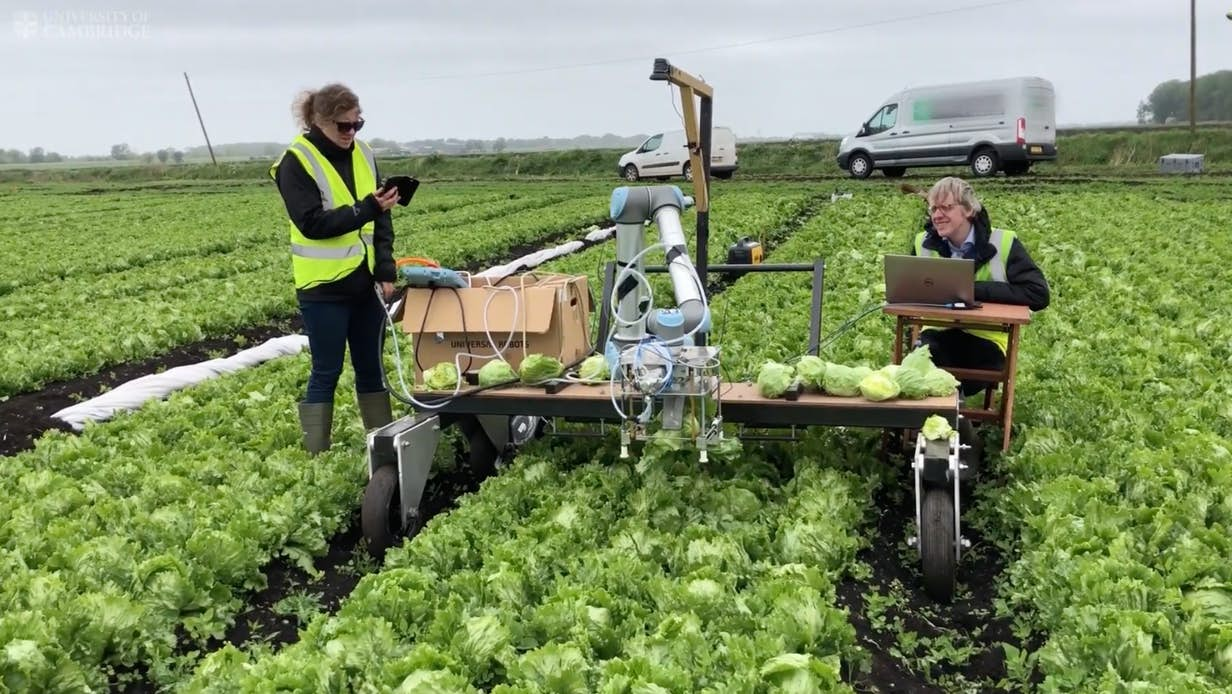Jul 16, 2019
Machine Learning Helps Robot Harvest Lettuce

CONTENT SOURCED FROM NEW ATLAS
Engineers from the University of Cambridge have developed a vegetable-picking robot that can autonomously identify and harvest iceberg lettuce, one of the more manually demanding crops for human pickers. Vegebot was trained using a machine-learning algorithm that helped it distinguish healthy lettuces ready for harvest, in a variety of different weather conditions.
Agricultural harvesting is one area of industry that has always embraced new technological advances. Some crops, such as wheat or potatoes, are relatively easy to harvest mechanically at a large scale, but other crops still require painstaking human labor to harvest. Developing an autonomous robotic system to pick a vegetable such as cucumber for example, has proved incredibly challenging.
Lettuce is another difficult crop that so far has proved resistant to automation. As well as growing flat to the ground and needing to be cut at precise points, a field of lettuce presents a novel challenge for robot vision, which needs to home in on an individual head of lettuce ready to be picked in a sea of green leaves.
"Every field is different, every lettuce is different," says study co-author Simon Birrell on the particular challenges in developing an autonomous lettuce-harvesting system.
The first, and arguably most complex, problem the engineers needed to solve in the development of a lettuce-harvesting robot was teaching the system to identify a healthy head of lettuce in a crowded green field. A machine learning algorithm was developed, and then trained the robotic system, first on images of lettuces and then on actual lettuces in laboratory conditions. Then, the system was moved into real-life field conditions to learn the look of a lettuce head for harvest across an assortment of different weather conditions.
The second challenge was to produce a way to make sure the robot could cut and pick each individual lettuce with the precision necessary to maintain a stem length according to commercial standards. This involved a custom-designed soft gripping arm, with a second camera near the cutting blade to ensure the cut is smooth and in the right location.
The resulting machine, called Vegebot, demonstrated impressive identification results, with a localization success rate of 91 percent. The system still needs work before it can be translated into a commercial solution, with a particularly high damage rate of around 38 percent reported. The researchers note that this damage rate means a significant volume of the picked lettuces did not meet supermarket standards, however they still remained edible.
Another hurdle to overcome is the speed of the system, with Vegebot averaging nearly 32 seconds to pick each lettuce. This is much slower than an average human picker but the researchers suggest lighter production materials should speed up this process.
On the more positive side of things, a system such as this could potentially reduce food waste as the robot can perform multiple passes of a single field, only picking specific fruit and vegetables it identifies as ripe. Current human harvesting methods generally only perform sweeps of fields on a single occasion, meaning unripe or unready fruit is picked and subsequently discarded.
"We're also collecting lots of data about lettuce, which could be used to improve efficiency, such as which fields have the highest yields," says co-author on the research, Josie Hughes. "We've still got to speed our Vegebot up to the point where it could compete with a human, but we think robots have lots of potential in agri-tech."
The new research was published in the Journal of Field Robotics.
Source: University of Cambridge
Further Reading
THE FARM OF THE FUTURE MIGHT BE ENTIRELY RUN BY ROBOTS
ARTIFICIAL INTELLIGENCE IN THE FOOD INDUSTRY: EMPOWERING FARMERS’ DECISION-MAKING
